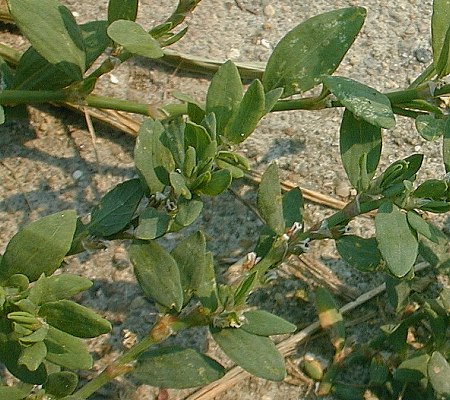Description: This plant is a more or less prostrate summer annual, producing hairless stems up to 3' long. The alternate leaves are up to 1" long and 1/3" (8 mm.) across. They are oblong or oblong-elliptic, smooth along the margins, and hairless. At the base of each leaf, there is a membranous sheath (ochrea) that wraps around the stem and hides the short petiole. This sheath becomes ragged and brown with age. The foliage of Prostrate Knotweed is often blue-green in appearance.

A small cluster of
1-5 nearly sessile flowers occurs at the base of each leaf toward the
growing point of each stem. Each tiny flower is about 2-3 mm. long,
consisting of 5 sepals, a style with a tripartite tip, several stamens,
and no petals. The flat sepals have white margins, otherwise they are
green, pink, or purple. The flowers bloom from mid-summer to early fall
for 2-3 months. These flowers open for only a short period of time when
the weather is hot and sunny. A 3-angled achene develops within the
sepals of each flower. This achene is reddish brown or brown and tapers
at one end more abruptly than the other. A fine membrane often clings
to the surface of this achene. The root system consists of a slender
shallow taproot that frequently branches. This plant spreads by
reseeding itself. Different varieties of Prostrate Knotweed have been
described, which are sometimes regarded as separate species.
Cultivation:
Typical growing conditions consist of full sun and a heavy soil that is
slightly moist to dry. This plant flourishes in poor soil where there
is little competition from other plants. It can withstand a fair amount
of trampling.
Range & Habitat:
Prostrate Knotweed (Polygonum
aviculare)
is a common plant that occurs in every county of
Illinois. It is adventive from Europe. Habitats include edges of roads
and driveways, cracks in sidewalks and pavement, compacted soil along
paths, and waste areas with barren ground. This species is found in
disturbed areas, especially in and around residential areas and cities.
It is more tolerant of road salt and pollution than most species of
plants.
Faunal Associations:
The small flowers probably attract
flower flies (Syrphidae) and small bees, although such floral visitors
are
uncommon. Insects that feed on the foliage, sap, and other parts of
Prostrate Knotweed and other knotweed species (Polygonum spp.)
include Chaetocnema
concinna (Brassy Flea Beetle), Capitophorus hippophaes
(Polygonum Aphid), the aphids Aspidaphis
adjuvans and Aphis
polygonata, and larvae of such moths as Grammia virguncula
(Little Virgin Moth), Haematopis
grataria (Chickweed Geometer), Nomophila nearctica
(Lucerne Moth), and Orthonama
obstipata
(The Gem); see Clark et al. (2004), Blackman & Eastop (2013),
Covell (1984/2005), and Wagner (2005). Many upland gamebirds and
granivorous songbirds eat the
seeds of these plants, including the Ring-necked Pheasant, Mourning
Dove, Cowbird, House Sparrow, Slate-colored Junco, and House Finch. The
Bird Table has a
more complete list of these species. In addition, the
nutritious seeds are eaten by the Thirteen-lined Lined Ground Squirrel,
White-footed Mouse, and House Mouse (Martin et al., 1951/1961;
Whitaker, 1966).
Photographic Location:
Several
flowering plants were growing from the crack of a city sidewalk
near Urbana, Illinois.
Comments:
Knotweed species (Polygonum spp.) with a prostrate
or spreading habit have been subjected to various taxonomic
classifications through the years. Some authorities regard Prostrate
Knotweed (Polygonum
aviculare)
as a single polymorphic species with several subspecies (USDA, ITIS),
while
other authorities identify several distinct species of prostrate
knotweed (Yatskievych, 2000; Mohlenbrock, 2014). The approach that has
been adopted here regards Prostrate Knotweed as a single polymorphic
species. In general, the different species or subspecies that have been
described are difficult to differentiate in the field. The most common
subspecies of Prostrate Knotweed in Illinois and North American
generally is Polygonum
aviculare depressum, which is referred to as Polygonum arenastrum
by the taxonomic splitters. These different subspecies or species are
differentiated from each other by such factors as the shape of their
leaves (either more broad or narrow), the constancy in the size of
their leaves (remaining about the same size or becoming smaller as they
approach the tips of the stems), the relative length of the inner and
outer sepals, and the shape of the tips of the sepals (hooded or flat).